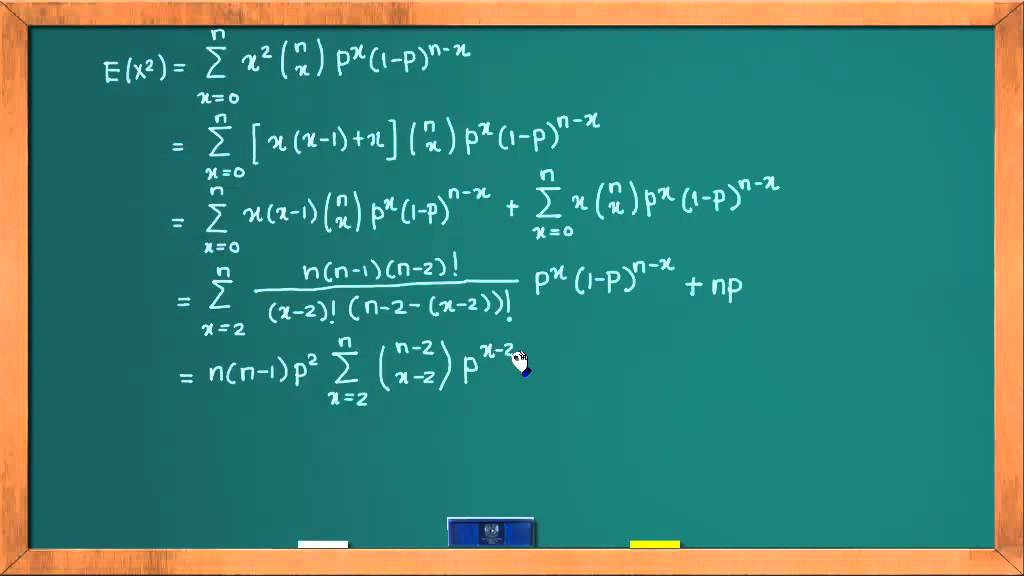Distribusi Peluang Variabel Acak Diskrit Part 3
Summary
TLDRThis tutorial explains how to calculate the value of a constant 'k' in a probability distribution and verify whether a given function is a valid probability function. The script covers various probability calculations, including summing probabilities and ensuring they add up to one. Additionally, it provides examples to demonstrate step-by-step how to handle different cases in probability, such as using combinatorics and evaluating functions with different parameters. The final goal is to confirm that the sum of all calculated probabilities equals one, proving the validity of the probability function.
Takeaways
- 😀 The goal is to find the value of 'k' for a probability distribution, ensuring that the sum of all probabilities equals 1.
- 😀 The formula used for the probability of variable X is given by P(X) = k * (X^2 - 8X).
- 😀 To determine the value of 'k', we calculate the probabilities for values of X from 0 to 8 and sum them.
- 😀 The sum of probabilities for X values from 0 to 8 results in a negative value, which helps find 'k' as -1/84.
- 😀 A valid probability distribution requires the sum of all probabilities to be 1, as demonstrated in the second example.
- 😀 In the second example, the probability function is P(X) = (X^2 + 2) / 38, where the calculations for X = 1 to X = 4 are shown.
- 😀 By summing the probabilities from X = 1 to X = 4, we confirm that the total is 1, validating the function.
- 😀 The third example shows a binomial-like probability function where probabilities for X = 0, 1, 2, 3 are calculated using the function.
- 😀 For each X value, the corresponding probabilities are calculated using combinations and powers of fractions, like 3/5 and 2/5.
- 😀 The key concept for validating a probability distribution is ensuring that the sum of all individual probabilities equals 1.
- 😀 The script concludes by confirming that all the probabilities in the third example sum up to 1, proving the function is a valid probability distribution.
Q & A
What is the primary focus of the transcript?
-The transcript primarily discusses probability distributions, specifically how to calculate and determine the value of a constant (k) in a probability mass function and how to verify if a given function is a valid probability function.
How do you determine the value of k in a probability distribution?
-To determine the value of k, you sum the probabilities of all possible outcomes and set the total equal to 1, as the sum of all probabilities in a probability distribution must be 1.
What is the general formula used to calculate the probability for each x in the given distribution?
-The probability for each x is calculated using the formula k * x^2 - 8x, where k is the unknown constant that is determined later by setting the sum of all probabilities equal to 1.
Why does the sum of the probabilities need to equal 1 in a probability distribution?
-The sum of the probabilities must equal 1 because it represents the certainty that one of the possible outcomes will occur. This is a fundamental property of any probability distribution.
How do you find the value of k when the sum of probabilities involves negative terms?
-You sum the negative terms along with the positive ones, and solve for k by setting the total sum equal to 1. In the given example, the total of the probabilities simplifies to -84k = 1, which gives k = -1/84.
What is the importance of checking if the sum of probabilities equals 1 in verifying a probability function?
-Checking if the sum of probabilities equals 1 is crucial because it confirms that the function is valid. A valid probability function ensures that the total probability of all outcomes equals 1, as required by probability theory.
What is the structure of the probability function provided in the second example (Example 12)?
-In Example 12, the probability function is defined as P(X = x) = (x^2 + 2) / 38. To verify that it is a valid probability function, the sum of the probabilities for all x must be equal to 1.
How is the sum of probabilities calculated for the second example (Example 12)?
-The sum of the probabilities is calculated by adding up the individual probabilities for x = 1, 2, 3, and 4. When the probabilities are summed, the total equals 1, confirming that the function is a valid probability function.
What does the notation '3 combinations x' (or 3C0, 3C1, etc.) mean in the context of the third example?
-The notation '3 combinations x' refers to the binomial coefficient, which is used in the binomial probability distribution formula. It represents the number of ways to choose x successes out of 3 trials, and is calculated as 3! / (x! * (3-x)!).
How do you verify that the binomial probability function sums to 1 in the third example?
-To verify that the binomial probability function sums to 1, you calculate the individual probabilities for x = 0, 1, 2, and 3, and sum them. When the probabilities are added, the total equals 1, confirming the validity of the function.
Outlines

This section is available to paid users only. Please upgrade to access this part.
Upgrade NowMindmap

This section is available to paid users only. Please upgrade to access this part.
Upgrade NowKeywords

This section is available to paid users only. Please upgrade to access this part.
Upgrade NowHighlights

This section is available to paid users only. Please upgrade to access this part.
Upgrade NowTranscripts

This section is available to paid users only. Please upgrade to access this part.
Upgrade NowBrowse More Related Video
5.0 / 5 (0 votes)





